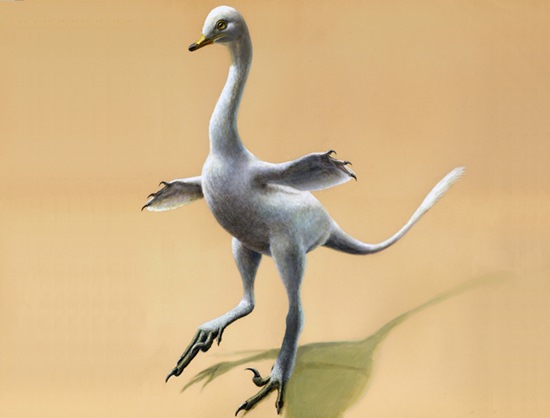
Washington (AP) – With a bill like a duck but teeth like a croc’s, a swanlike neck and killer claws, a new dinosaur species uncovered by scientists looks like something Dr. Seuss could have dreamed up.
 It also had flippers like a penguin, and while it walked like an ostrich it could also swim. That’s the first time swimming ability has been shown for a two-legged, meat-eating dinosaur.
It also had flippers like a penguin, and while it walked like an ostrich it could also swim. That’s the first time swimming ability has been shown for a two-legged, meat-eating dinosaur.
The tiny creature, only about 18 inches (45 centimeters) tall, roamed 75 million years ago in what is now Mongolia. Its full curled-up skeleton was found in a sandstone rock.
“It’s such a peculiar animal,” said Dennis Voeten, a paleontology researcher at Palacky University in the Czech Republic. “It combines different parts we knew from other groups into this one small animal.”
In a study released Wednesday by the journal Nature, Voeten and coauthors named it Halszkaraptor escuilliei (HAHL-shka-rap-tor ES-key-lay-ee) or “Halszka” after the late Polish paleontologist Halszka Osmolska.
Paleontologist Kristi Curry Rogers of Macalester College in St. Paul, Minnesota, who didn’t participate in the study, called it “a pretty crazy chimera: a swan neck and dinosaur body, but with a mouthful of tiny teeth and hands and feet that look like they might be good for swimming.”
Its mashup body let it run and hunt on the ground and fish in fresh water, said study co-author Paul Tafforeau. He’s a paleontologist at the ESRF, known as the European Synchrotron in Grenoble, France, a powerful X-ray generator where numerous tests were made on the fossil.
Lead author Andrea Cau, a paleontologist at the Geological Museum Capellini in Bologna, Italy, said he was at first highly suspicious about the fossil’s authenticity, both because of its appearance and the fact that the rock containing the skeleton had been smuggled out of Mongolia and left in a private collector’s hands.
“I asked myself, ‘Is this a real, natural skeleton, or an artifact, a chimera? If this is a fake, how could I demonstrate it?’” Cau said in an email. “Assuming it was a fake instead of starting assuming that the fossil is genuine was the most appropriate way to start the investigation of such a bizarre fossil.”
So researchers used the Synchrotron to create three-dimensional images of the fossil, which showed the creature was indeed a single animal and not a concoction built up from several sources. For example, an arm hidden in the rock perfectly matched the visible left arm, and lines indicating growth matched up across the bones.
Even though the creature wasn’t dreamed up by Dr. Seuss, it got a blessing from a Dr. Sues.
Hans Sues, a paleontologist at the Smithsonian Institution who wasn’t part of the research, praised the work and said it “shows again how amazingly diverse dinosaurs were.”





